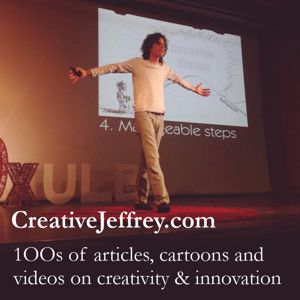Report 103
Your newsletter on applied creativity, imagination, ideas and innovation in business.
Tuesday, 16 October 2007
Issue 115
Hello and welcome to another issue of Report 103, your fortnightly newsletter on creativity, imagination, ideas and innovation in business.
As always, if you have news about creativity, imagination, ideas, or innovation please feel free to forward it to me for potential inclusion in Report103. Your comments and feedback are also always welcome. E-mail me at jeffreyb@jpb.com.
Information on unsubscribing, archives, reprinting articles, etc can be found at the end of this newsletter.
SOLICITING IDEAS FROM THE PUBLIC
Idea management typically focuses on soliciting ideas from employees within a firm. However, companies' customers and business partners are also rich sources of ideas. Even people who are not your customers may have great ideas about how you could turn them into your customers.
Thus, idea management tools that allow businesses - or, indeed non-profits, government bodies and others - to solicit and capture ideas from the public would seem to be a very good idea. Indeed, companies have been attempting to do this for years, typically through suggestion boxes found in service oriented businesses such as hotels and restaurants. These days, however, the Internet makes it even easier to solicit and capture ideas from the public.
Hi-Tech Sugggestion Boxes
Two companies have in the past year launched high profile public web sites designed to solicit ideas from their customers. I deeply admire their efforts and investment in their initiatives. Unfortunately, both firms' web based tools are seriously flawed conceptually – and the consequences are beginning to show already.
The companies in question are Dell and Salesforce.com and their initiatives are IdeaStorm at http://www.ideastorm.com/ and IdeaExchange at http://ideas.salesforce.com/ respectively. Both sites invite people to register, submit ideas, comment on ideas and promote ideas. Ideas which are promoted rise higher in the heap of ideas and so are more likely to be seen, further promoted and, presumably, identified by company managers as ideas to be taken seriously.
We will look at Dell's IdeaStorm simply because I am not familiar with Salesforce.com's product other than conceptually. On the other hand, we use Dell computers in our office and are generally happy with them and Dell's service.
The Problem with Open Suggestion Systems
The biggest problem with an open idea submission scheme is you get all kinds of ideas on all kinds of issues, many of which are completely irrelevant to your business needs. That's why we have developed and promote our ideas campaign approach to idea management and innovation. Rather than say, as a suggestion scheme does: “give me your ideas on anything that captures your fancy”; ideas campaigns say: “we have a specific problem and we challenge you to come up with creative solutions.”
Thus, a better approach for any company seeking ideas from the public would be to run web based ideas campaigns centred around specific challenges such as: “In what ways might we make our computers easier to use for non-experts?” or “How might we make our laptops better meet your needs?”
Not only would such challenges focus creative thinking on the company's immediate business needs, but they would also be motivational. It's always easier to come up with ideas when you are challenged: compare trying to come up with any idea for a computer manufacturer as opposed to responding to one of the challenges I suggested above.
If there Is no Challenge, Most People Will Make One Up
Without a challenge, participants in any suggestion scheme will create their own challenges as a springboard for creative thinking. In the case of IdeaStorm, the obvious implied challenge is: “In what ways would Dell computers be more appealing to me?”
And this is the case. Most of the ideas on IdeaStorm seem to be requests related to the Linux operating system. Further reading of these suggestions indicates that the bulk of the users of IdeaStorm are highly knowledgeable computer users most likely purchasing machines for their own use. This is great if that is the main group the company is trying to target.
On the other hand, if they are targeting corporate buyers or non-expert users, the ideas are largely useless. A low cost Linux option on a computer wouldn't impress my mother – who very possibly doesn't even know what Linux is – and probably wouldn't make much difference to corporate buyers who need to run Windows anyway.
On the other hand, features that make the computer simpler to use would impress my mother and corporate IT departments which spend many hours solving employees' computer related problems. At a quick look, there do not seem to be many IT managers or people like my mother on IdeaStorm.
The computer manufacturer could get ideas from such people firstly by running ideas campaigns that target issues relevant to their needs and secondly by explicitly inviting people like my mother and corporate IT buyers to participate in those ideas campaigns. Incentives such as rewards, the opportunity to win computers and the like could further encourage participation in ideas campaigns.
Ideas Campaigns Are Short Term
Moreover, ideas campaigns are short-term. Ideas are solicited over a very few weeks. Then the campaign is closed and ideas are evaluated and the best ideas chosen for implementation – or at least further testing. The campaign is eventually archived for future reference. By using ideas campaigns as individual components that make up a long term innovation initiative, you avoid getting an increasing pile of unused ideas – a problem in any open suggestion scheme.
Regular ideas campaigns on different challenges would not only ensure that the company got ideas relevant to their business needs, but would also stimulate their customers more effectively than an empty request for ideas. Challenges would also break up the clumping of ideas on specific themes – such as Linux implementations.
Likewise, targeting various types of customers and motivating them with incentives ensures that a wider variety of people generate a wider variety of ideas. And that leads to a higher level of creativity and – eventually – innovation.
Acting on Suggestions Is Difficult When there Are too Many
If you want evidence that IdeaStorm is having problems, you need only look at one of the top ideas: “Wake up Dell IdeaStorm is dying quickly.” A large number of the comments are highly critical and several note that the problem is that Dell is only implementing a very few ideas. As one of the comments states: “What Dell needs to re-inspire IdeaStorm is to ACTUALLY ACT ON SOME OF THE IDEAS ALREADY POSTED.”
What the author of that comment and many others do not realise is that because Dell is not focusing creative thinking on their actual needs, such as via ideas campaigns, they are not getting the ideas they need.
On a more positive note, Dell is publicly implementing some of their ideas. A page entitled “Ideas in Action” describes several IdeaStorm ideas that Dell is implementing. I did not see any similar component on Salesforce.com's idea site.
Once again, I would like to stress that I believe Dell's and Salesforce.com's initiatives are marvellous and to be encouraged. However, they need seriously to rethink their approach before their idea web sites die out.
Idea Management Principles
If you are familiar with in-house idea management, that is soliciting ideas from employees, you will recognise that the principles of public idea management are essentially the same:
-
You need to focus innovation on business ideas through the use of ideas campaigns
-
You need to motivate people to participate, through publicity and rewards schemes
-
You need to show people you are actually implementing their ideas
If you would like more information about ideas campaigns or how they are implemented in our idea management solution – Jenni – please visit http://www.creativejeffrey.com/jenni/.
JENNI ON FACEBOOK
If you want to solicit ideas from the public, what better place to do so than a highly popular social networking web site with 40 million user. A place like Facebook, for example. We have not only made it possible, but we have actually made it easy by modifying a Jenni software engine and turning it into a “Facebook App”, that is: a web application that [sort of] runs on Facebook.
As of yesterday, any Facebook user can access Jenni on Facebook. This allows the user to participate in ideas campaigns (although we call them “creative challenges” on Facebook) by reading the challenges, browsing ideas, submitting ideas and collaborating on ideas.
Moreover, when a Facebook user submits an idea or a building block (an elaboration of an existing idea) to Jenni, she and friends in her network receive a notification of her idea submission. Better still, every Facebook user of Jenni has a space in her profile with information about Jenni, her performance in Jenni, current creative challenges and rewards received. This motivates Facebook users to participate more and sparks interest from their friends.
Back Office Is Where Ideas Are Managed
In addition to the Facebook face of Jenni, there is also a back office where creative challenges are launched and promoted and where promising ideas are selected and sent to experts for peer-review evaluation. It is also possible to route ideas submitted on Jenni on Facebook to a secure non-Facebook implementation of Jenni for further development by employees. Of course the idea management back office of Jenni is not on Facebook and is not available to Facebook users. Rather it is controlled by us or corporate clients of Jenni on Facebook.
This means that companies that wish to tap into the collective creative mind of millions of Facebook users can run creative challenges on Jenni, solicit ideas and then use Jenni's evaluation tools to evaluate ideas.
Rewards for Motivation and Marketing
In addition, we recommend companies establish a rewards scheme for ideas. This might include coupons, small gifts or the possibility to collect points that can be exchanged for products. Such a rewards scheme not only encourages idea submission, but allows companies to build up mailing lists of valuable customers and potential customers.
Of course, corporate clients of Facebook on Jenni will also get immediate access to our innovation and idea management expertise.
If you would like to discuss Jenni on Facebook, contact your nearest Jenni service partner
Facebook on Jenni is still in Beta. It is fully functional, but we are tweaking it a little here and there and adjusting text so that it better fits the Facebook environment.
If you are a Facebook user, you can try out Facebook on Jenni at http://apps.facebook.com/jenni_ideas/
WHEN TO KILL AN IDEA
If you are running an innovative organisation, you need to kill a lot of ideas. Indeed, you are probably doing so already. The problem most people and organisations have is that they tend to kill ideas at the wrong times – either too early or too late – and this is very detrimental to their innovation process.
In fact, most ideas are killed way, way too early. Consider the following exchange, variations of which can be heard daily in corporate corridors around the world:
Subordinate Sam: “I was just thinking. If we added wi-fi connectivity to our widgets, our customers...”
Managing Martha: “You must be joking! It would add to costs and what reasons would our customers possibly have for connecting wirelessly to the web?”
Sam: “well, I thought...”
Martha: “I'm sorry, I'm on my way to a meeting now. I trust the financial projections for the next quarter will be on my desk by the end of business today!”
In just a few seconds, Managing Martha has killed an idea without even trying to understand it. Worse, if she does this a couple more times, she will essentially communicate to Sam and others that she does not welcome ideas. And they will learn to keep ideas to themselves. Sadly, this happens all the time in all but the most innovation-enlightened companies.
Idea Generation or Extermination Actions?
Sadly, even when organisations purposely attempt to generate creative ideas, such as through brainstorming events, suggestion schemes and other activities, they often kill ideas off too early. Sometimes they even kill ideas during the idea generation activities.
A worst case example was told to me by a manager of a global engineering firm. She explained how the company had set up a suggestion scheme to solicit ideas from employees. Moreover, they decided that it was critical to give idea submitters feedback as soon as possible in order to demonstrate that they were acting on all ideas received. Every idea was evaluated within a couple of weeks of submission and a report sent to the submitter.
Like most suggestion schemes (see also the first article in this issue of Report 103), this one did not use ideas campaigns to focus creative thinking on specific business needs. As a result, all kinds of ideas came in. Most of them, of course, were unrelated to current business needs. Many were not even related to the company's business at all! Following policy, idea submitters promptly received rejection notices.
In no time, staff worked out that submitting an idea to the suggestion scheme was a sure-fire method of getting a critical idea rejection notice and, not surprisingly, the initiative died within weeks of its kick-off.
This same problem plagues many poorly facilitated brainstorming events, where participants, and particularly senior manager participants, criticise ideas during the idea generation. Other participants quickly learn that wild ideas are going to be criticised and learn to keep their creativity to themselves.
Poorly Structured Evaluation Can Kill Promising Ideas too Quickly
If ideas make it past the creative idea generation process, the next step is to evaluate them in order to determine how well they meet corporate needs. In theory, this is a good time to kill ideas. You have generated a lot of ideas and now you need to select the best. This is normally done via some kind of evaluation process in which the idea is compared to one or more criteria for viability.
The danger here is that sometimes ideas might not initially meet a critical criterion. But with some modification, those ideas can be made to meet the criterion. For instance, you might be reviewing a number of ideas to determine which ones could be implemented on a budget of $1 million. A particularly clever idea may, on first instance, seem to need a budget of twice that to implement. As a result, the idea is likely to be killed.
But, if the reviewers had asked themselves, how might we do the same thing at half the cost, they might not only have found a solution, but they might have made the idea even better.
Five Criteria Are Best
Thus it is always better to evaluate particularly promising ideas according to several criteria (in our experience, five criteria work best). If an idea fails on one criterion, but scores highly on the others it will still have a relatively high score and remain in consideration for implementation.
In addition, if you are truly keen on high level innovation, you should always earmark the craziest, most outlandish and most creative ideas for further consideration. Such ideas may fail your regular evaluation tests because they are so unusual. You may have to create special evaluations to determine their viability.
In summary, ideas have a difficult birth and precious few actually survive to become projects – arguably the next stage in idea development. But when they do become projects, they become almost indestructible!
Indestructible Projects
Unlike an idea, a project requires people to manage it. It requires a budget and should have clear goals. As the project develops, the people running it often establish an emotional attachment to it. Moreover, they realise that the project's failure might at best be damaging to their reputations and at worst be detrimental to their futures in the firm. The failure of a large project could result in people losing their jobs and corporate loss of face.
The result is, once an idea becomes a project, the people behind it are less likely to want to kill it – no matter how bad the results are. To make matters worse, the longer project managers keep a bad project going, the greater the consequences of failure: more money is wasted, more people are affected and more damage is done to reputations. So, ironically, the worse a project becomes the harder it becomes for those behind it to kill the project.
This has consequences. As budget and resources are being sucked up by a once promising idea that has become a bad project, there is less budget and resources for other promising ideas.
This, in fact, ruined many e-businesses that were devised during the dot-com boom of the late 1990s. Many had good, creative ideas behind them, but those ideas turned bad in their implementations. Sadly, rather than killing off bad ideas early on, managers sought – and often found – more venture capital to throw at their ideas, making their failures even more spectacular.
Boo.com, a UK based on-line fashion retailer that went bust in 2000, blew over £80 million on developing a very innovative, cutting edge web site that included a virtual assistant and Flash based tools for displaying garments. Sadly, these tools sucked bandwidth at a time when most consumers were connecting to the Internet with slow dial-up modems. Worse, usability was appalling.
As Boo.com failed, managers did not dump the innovative tools and try alternative approaches. Rather they threw more money at the tools and marketing. In the end, Boo made history but few sales.
Establish a Balance of Idea Killing
Clearly, what organisations need to do is to allow more ideas to live longer during the early idea generation and incubation stage. Indeed, more ideas should become projects. But, those projects need to have very clear milestones which must be reached at an early stage of the project. If those milestones are not reached, the project should be quietly killed and resources applied to a new project.
Likewise, managers behind projects should not be reprimanded if their projects do not reach early milestones. Rather, they should be rewarded for being sensible and encouraged to share their learnings with their colleagues in order to prevent similar failures in the future.
And then they should be given newly incubated projects to work on.
IMAGINATION CLUB ON-LINE
In addition to the Imagination Club Brussels, we also support the Imagination Club on-line discussion forum. The discussion forum is a place to share ideas, stretch your imagination and talk about creativity and innovation. Imagination Club members come from around the world and are a rather amazing bunch. More info at http://www.imaginationclub.org/
LATEST IN BUSINESS INNOVATION
If you want to keep up with the latest news in business innovation, I recommend Chuck Frey's INNOVATIONweek (http://www.innovationtools.com/News/subscribe.asp). It's the only e-newsletter that keeps you up-to-date on all of the latest innovation news, research, trends, case histories of leading companies and more. And it's the perfect complement to Report 103!
Happy thinking!
Jeffrey Baumgartner
---------------------------------------------------
Report 103 is a complimentary weekly electronic newsletter from Bwiti bvba of Belgium (a jpb.com company: http://www.creativejeffrey.com). Archives and subscription information can be found at http://www.creativejeffrey.com/report103/
Report 103 is edited by Jeffrey Baumgartner and is published on the first and third Tuesday of every month.
You may forward this copy of Report 103 to anyone, provided you forward it in its entirety and do not edit it in any way. If you wish to reprint only a part of Report 103, please contact Jeffrey Baumgartner.




